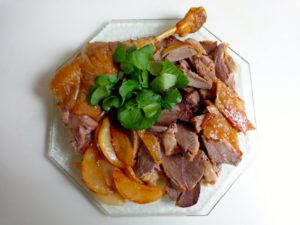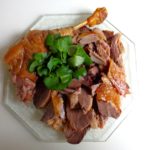
Roast Christmas goose
There is nothing much simpler than roasting a goose. You basically put it in the oven and wait for it to be done. The art is in choosing what you will serve with it.
Fruit goes well, for example slices of pear or apple sautéed in butter, and so does cabbage, steamed or sautéed. In Eastern Europe it’s traditional to serve goose with red cabbage and apple sautéed together, with perhaps with a hint of vinegar some cumin seeds tossed in. Anything green will enliven the platter — bouquets of watercress or mâche work nicely. You could add a grain, like wild rice or bulghur with red onion, or go the classic route with potatoes sautéed in the grease of the goose.
If you’d like to stuff the goose, chop the liver and fry in olive oil with minced onion. Add some bread cubes, salt and pepper, and a little fresh sage or thyme. You could also add a chopped apple. Stuff the cavity and close with a heel of bread. You can also bake the stuffing separately. Moisten with a ladle or two of homemade chicken broth or, better, broth made with the neck of the goose, and bake in the oven for 15 minutes.
To ensure that your goose is tender and not fatty, prick the skin with a fork before roasting, baste and skim away the fat every now and then, and don’t overcook. For easy serving, you can roast and carve the goose ahead of time, reheating it in the oven just before serving. To keep it moist, line a tin with parchment paper, add the sliced goose, place bits of skin over the meat and cover with foil.
Pair the goose with a hearty red, for example a Côtes du Rhone or a sturdy Bordeaux. Bon appétit!
1 goose, about 9-10 pounds (4-4.5 kilos)
1 tbsp. olive oil
If you plan to stuff the goose, make the stuffing ahead of time (see above).
Your goose should be at room temperature when you begin. Pull as much fat as you can from the cavity. Do not discard — you can melt it, strain it, pour it into a jar and keep it in the fridge all winter for frying potatoes.
Preheat the oven to gas mark 7 (400 F, 210 C). If you plan to stuff the goose, do that now.
With a fork or the tip of a knife, prick the goose all over to allow it to release the rest of its fat while roasting. Spread a little olive oil in your roasting pan and rub the rest over the goose.
When the oven is hot, begin roasting. After 10 minutes, turn down the heat to gas mark 6 (350 F, 180 C). The goose will give off a lot of fat. Every half hour, remove the roasting pan from the oven and baste the goose with the fat. Then skim the fat out of the pan with a large spoon or a turkey baster. Discard or save the fat and return the goose to the oven.
Count 15 minutes per pound (500 g) of goose. That works out to about 2-1/4 hours for a 9-pound goose, and 2-1/2 for a 10-pound goose. But be careful — the roasting time will depend on your oven. Check half an hour before the time expires by inserting a fork into the thickest part of the goose. If the juice runs clear, it’s done. If not, continue roasting.
 When the goose is done, let it sit for a few minutes before carving. Cut away the legs and wings, carve the breast meat and transfer to a platter — or, if you’ve prepared the goose ahead of time, place it in a tin for reheating as described above.
When the goose is done, let it sit for a few minutes before carving. Cut away the legs and wings, carve the breast meat and transfer to a platter — or, if you’ve prepared the goose ahead of time, place it in a tin for reheating as described above.
When ready to serve, surround the goose with the side dishes you’ve prepared and carry it to the table. Prepare for applause. Serves 8-10.




